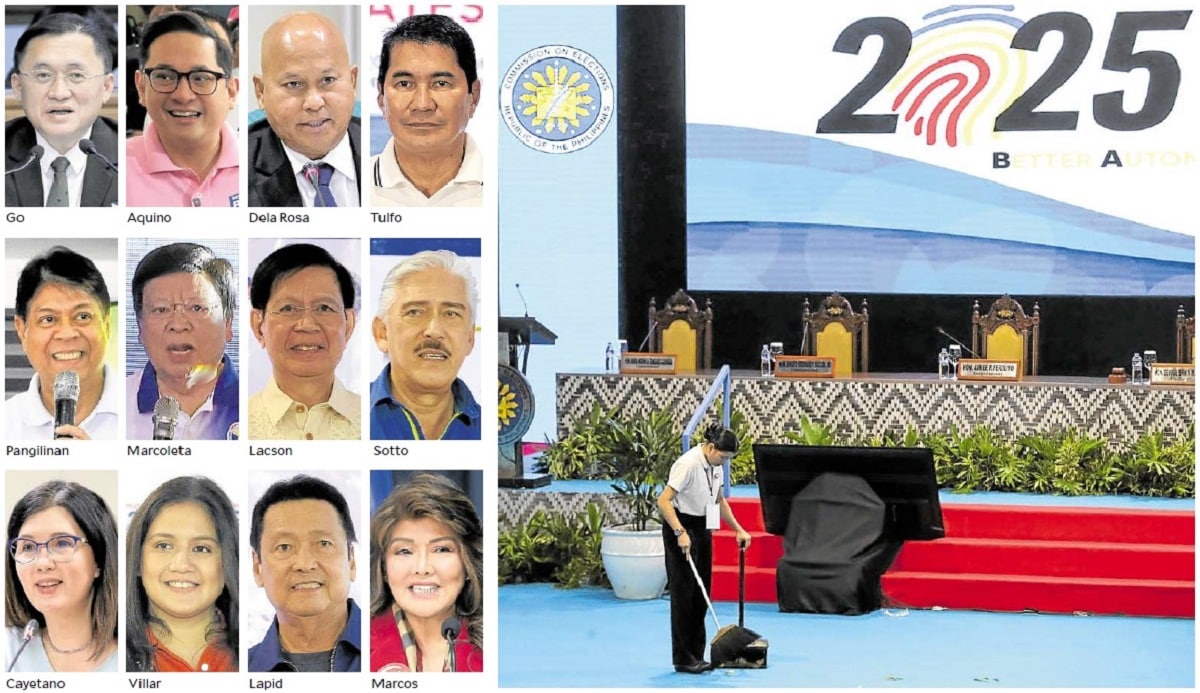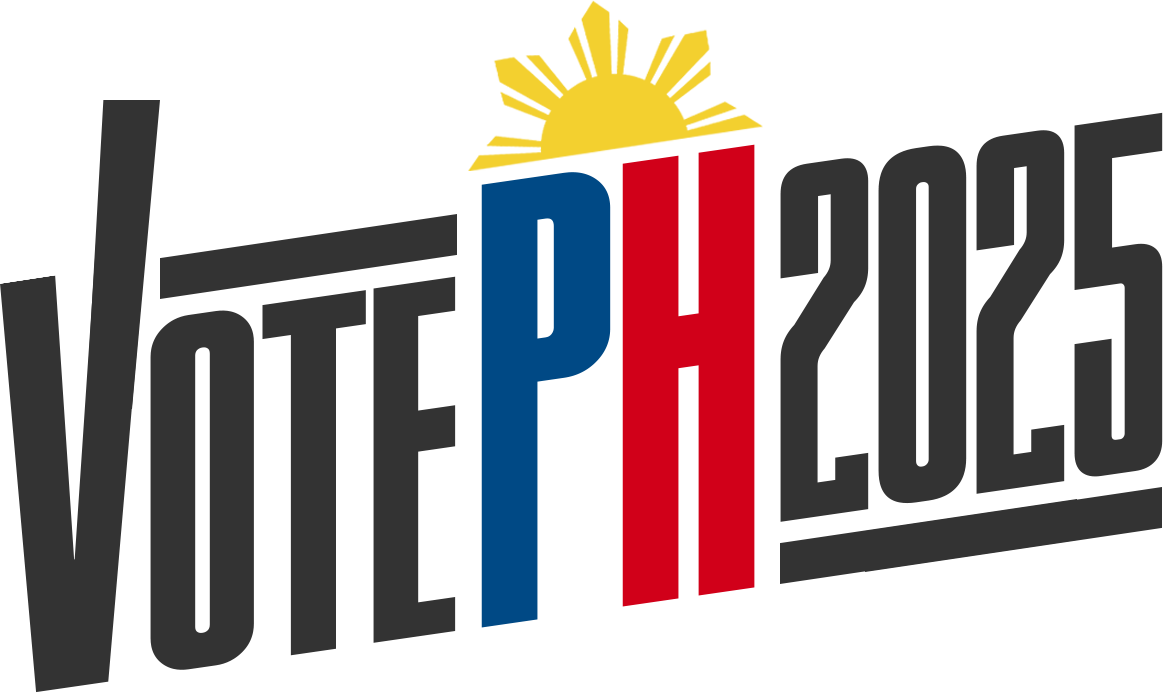Senate ‘Magic 12’ mixed bag of political ties

TAUT BALANCE, TWIN SURPRISES The winners of the May 12 senatorial race reflect the escalating tug-of-war between the Marcos and Duterte power blocs—plus two victors from the “pink opposition” who proved many preelection surveys wrong. The Comelec canvassing venue at the Manila Hotel is prepared on Friday for their scheduled proclamation today (right photo).
It’s official: five candidates under the Marcos administration-backed ticket, five endorsed by the Duterte camp, and two liberal opposition stalwarts won the May 12 Senate race, according to the final tally of the Commission on Elections (Comelec).
The Comelec on Friday released the national certificates of canvass (NCOCs) ranking the 66 senatorial and 156 party list candidates, the number of votes they received, and the percentage of votes cast in relation to the turnout.
The 12 winning senatorial candidates are: Bong Go (27,121,073 votes); Bam Aquino (20,971,899); Ronald “Bato” dela Rosa (20,773,946); Erwin Tulfo (17,118,881); Francis “Kiko” Pangilinan (15,343,229); Rodante Marcoleta (15,250,723); Panfilo “Ping” Lacson (15,106,111); Vicente Sotto III (14,832,996); Pia Cayetano (14,573,430); Camille Villar (13,651,274); Lito Lapid (13,394,102); and Imee Marcos (13,339,227).
The results are similar to the tallies released by poll watchdogs and media entities which have been assigned servers by the Comelec.
The composition of the new set of senators is keenly watched because of the impeachment trial of Vice President Sara Duterte that is set to start on July 30.
The Duterte-backed PDP Laban fielded Go, Dela Rosa, Marcoleta, and later adopted Villar and Marcos as guest candidates. Those who ran under the administration Alyansa Para sa Bagong Pilipinas were Tulfo, Lacson, Sotto, Cayetano and Lapid.
While Aquino and Pangilinan ran under different parties, their Katipunan ng Nagkakaisang Pilipino and Liberal Party are part of the opposition coalition that also includes Akbayan, which led the party list race.
Party-list seats filled up
Six party list groups won more than 2 percent of votes cast, guaranteeing them at least one seat in the House of Representatives. Aside from Akbayan, these are Duterte Youth, Tingog, 4PS, ACT-CIS and Ako Bikol. The 63 seats allotted for party list groups are expected to be filled up.
According to NCOC data, a total of 57,350,968 ballots were cast. With 69,673,653 total registered voters, the voter turnout was 82.2 percent.
READ: Comelec to proclaim Senate Magic 12 winners on Saturday
At a press conference, Comelec Chair George Garcia said the proclamation of the wining senators will be held on Saturday and that of the party list groups on Monday.
The Comelec completed the national canvass around 9 p.m. on Thursday.
Namfrel assessment
Meanwhile, the National Citizens’ Movement for Free Elections (Namfrel) noted “alarming” developments in its preliminary assessment of the conduct of the polls.
Namfrel Chair Angel Averia Jr., reading the poll watchdog’s statement, said that while the May 12 exercise was generally peaceful and orderly, elections in some parts of the country were “marred by violence and other public disturbances that caused disruption and delay in the conduct of Election Day processes.”
It asked the Comelec to explain several issues, including the delay in receiving and the double recording of election returns (ERs) to the servers assigned to watchdogs, media entities and political parties.
“The expectation set during Comelec briefings was that stakeholders will receive electronically transmitted election returns shortly after the close of polls and in 15-minute intervals after receipt of the first transmission. This expectation was not met,” Averia said.
“Stakeholders received empty results packages between the close of polls and 8:56 p.m., the time when the first results package that contained 30 percent of the expected election returns was received,” he added.
The Comelec explained that the first set of ERs received was packed into a results package and delivered to the stakeholders’ assigned servers. The next set of ERs received was similarly packed into a results package together with the previously received ERs. The subsequent ERs received were packed in the same manner.
“Packing the ERs into results packages is unnecessary and simply allows the stakeholders to decrypt each ER received by providing the stakeholders the password for decryption,” Averia explained.
He also raised issues concerning the automated counting machines (ACMs), including overheating and dirty scanners, causing ballots to be rejected.
Violent incidents
Averia said another “common observation” made by Namfrel volunteers inside polling places was the lack of vote secrecy.
In some cases, members of the electoral boards—not the voters—were the ones inserting the filled-out ballots, he said.
There was also a shortage of ballot secrecy folders that prolonged the process for voters.
Namfrel also condemned the violent incidents reported and verified by its observers in several municipalities of Lanao del Sur, in Silay City, Negros Occidental, and in Datu Odin Sinsuat, Maguindanao del Norte.
“Violence has no place in a democratic society. Namfrel encourages authorities to thoroughly investigate these incidents and bring the perpetrators to justice,” the group said.
Bright spots
But Namfrel found some “bright spots,” such as the setup of voter assistance desks, the presence of onsite volunteers ready to assist especially members of vulnerable sectors, and the early start of voting hours.
READ: Comelec national canvass: Senate race results
The watchdog also released two apps for the May 12 polls. The first is an ER QR code scanning app called OQC 2025 available to the public, and a VVPAT (voter-verified paper audit trail) scanning app available to select Namfrel volunteers.
OQC 2025 enabled any citizen, not just Namfrel volunteers, to independently verify transmitted election results by scanning the QR codes printed on the election returns posted outside polling places, and on the VVPATs.
There were 4,312 downloads for the public app and 668,671 ER QR codes scanned representing 2,787 distinct precincts nationwide. Transmissions came from Luzon, Visayas and Mindanao.
“Namfrel will be submitting a final report to the Comelec on the findings of its observation, identifying areas that could be further strengthened, and recommending measures to help ensure the conduct of more efficient and transparent electoral exercises,” Averia said.



















